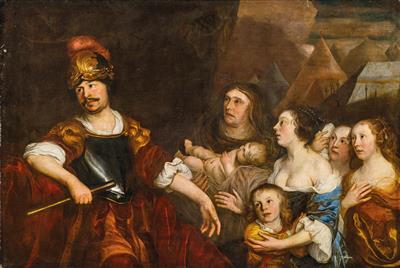Abraham Lambertsz. van den Tempel

(Leeuwarden 1622/3–1672 Amsterdam)
Portrait of a family in the guise of Volumnia and her children before Coriolanus,
oil on canvas, 128 x 190 cm, framed
Provenance:
Collection of Auguste de Montferrand (1786–1858), architect of the Saint Isaak Cathedral, Saint Petersburg (according to a label on the reverse);
Collection of Count Wasem[ski?], sold in January 1896 (according to a label on the reverse);
Private collection, Genoa
We are grateful to David de Witt for confirming the attribution of the present painting on the basis of a high-resolution digital photograph. David de Witt, who recently completed the Saur Lexikon entry on Van den Tempel, considers the present painting a fine early work by the artist, preceding the depiction of the same subject sold at Christie’s, Amsterdam, 10 November 1997, lot 136. He dates the present work to 1648-50.
Abraham van den Tempel was the son of the painter and Mennonite preacher Lambert Jacobsz, who trained Govaert Flinck, possibly alongside the young Abraham. Active in Leiden and Amsterdam, van den Tempel became one of the leading Dutch portrait painters of the third quarter of the seventeenth century. Despite his success as an artist, van den Tempel, from 1645, also ran a thriving cloth business in Leiden, which may explain why the handling of drapery in his pictures is so refined, their textures often amplified by dynamic light effects. Significant commissions include three giant allegorical scenes for the monumental guildhall of Leiden’s cloth merchants, which still hang in their original setting, now styled the Stedelijk Museum de Lakenhal. The most famous of van den Tempel’s pupils was Frans van Mieris I.
Coriolanus, as told in Plutarch’s Lives and re-imagined by Shakespeare, was a Roman commander who after a dispute with the tribunes of the plebs defected to Rome’s rivals the Volsci, returning with a Volscian army and laying siege the city. After initial envoys failed in persuading Coriolanus to call off the attack, the city’s matrons, led by his wife, Volumnia, came out from Rome’s walls to plead with him, and convinced him to lift the siege, thereby saving the city. The choice of story acts as an allegorical example of the strength of familial bonds. As a Mennonite, van den Tempel would have been a pacifist, although the subject was more likely the choice of the sitters, perhaps wealthy co-religionists.
22.10.2019 - 17:00
- Estimate:
-
EUR 80,000.- to EUR 120,000.-
Abraham Lambertsz. van den Tempel
(Leeuwarden 1622/3–1672 Amsterdam)
Portrait of a family in the guise of Volumnia and her children before Coriolanus,
oil on canvas, 128 x 190 cm, framed
Provenance:
Collection of Auguste de Montferrand (1786–1858), architect of the Saint Isaak Cathedral, Saint Petersburg (according to a label on the reverse);
Collection of Count Wasem[ski?], sold in January 1896 (according to a label on the reverse);
Private collection, Genoa
We are grateful to David de Witt for confirming the attribution of the present painting on the basis of a high-resolution digital photograph. David de Witt, who recently completed the Saur Lexikon entry on Van den Tempel, considers the present painting a fine early work by the artist, preceding the depiction of the same subject sold at Christie’s, Amsterdam, 10 November 1997, lot 136. He dates the present work to 1648-50.
Abraham van den Tempel was the son of the painter and Mennonite preacher Lambert Jacobsz, who trained Govaert Flinck, possibly alongside the young Abraham. Active in Leiden and Amsterdam, van den Tempel became one of the leading Dutch portrait painters of the third quarter of the seventeenth century. Despite his success as an artist, van den Tempel, from 1645, also ran a thriving cloth business in Leiden, which may explain why the handling of drapery in his pictures is so refined, their textures often amplified by dynamic light effects. Significant commissions include three giant allegorical scenes for the monumental guildhall of Leiden’s cloth merchants, which still hang in their original setting, now styled the Stedelijk Museum de Lakenhal. The most famous of van den Tempel’s pupils was Frans van Mieris I.
Coriolanus, as told in Plutarch’s Lives and re-imagined by Shakespeare, was a Roman commander who after a dispute with the tribunes of the plebs defected to Rome’s rivals the Volsci, returning with a Volscian army and laying siege the city. After initial envoys failed in persuading Coriolanus to call off the attack, the city’s matrons, led by his wife, Volumnia, came out from Rome’s walls to plead with him, and convinced him to lift the siege, thereby saving the city. The choice of story acts as an allegorical example of the strength of familial bonds. As a Mennonite, van den Tempel would have been a pacifist, although the subject was more likely the choice of the sitters, perhaps wealthy co-religionists.
|
Buyers hotline
Mon.-Fri.: 10.00am - 5.00pm
old.masters@dorotheum.at +43 1 515 60 403 |
| Auction: | Old Master Paintings I |
| Auction type: | Saleroom auction |
| Date: | 22.10.2019 - 17:00 |
| Location: | Vienna | Palais Dorotheum |
| Exhibition: | 12.10. - 22.10.2019 |
